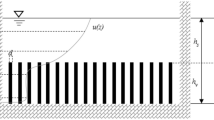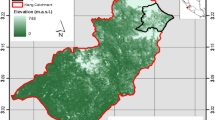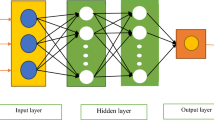Abstract
Three forecasting models, i.e., the least squares support vector machine (LSSVM), the neural network with back-propagation algorithm (BP), and a hybrid approach called APSO-LSSVM, are presented in this paper to predict the throughput of coal ports. A comparative study on the prediction accuracy among the three models is conducted. The purpose of this comparative study is to provide some useful guidelines for selecting a more accurate model to predict the throughput. The comparative results experimentally show that, in comparison with LSSVM and BP, the APSO-LSSVM has the more accurate accuracy and the better generalization performance regarding the indexes average error, mean absolute error and mean squared error.







Similar content being viewed by others
Explore related subjects
Discover the latest articles, news and stories from top researchers in related subjects.References
Chen G, Lei L, Zou H (2012) China’s port throughput of iron ore forecast based on cubic exponential smoothing method. J Econ Res Guide 4(150):191–193
Chen X-y, Gu H (2010) Application of gray linear regression model for forecast of port throughput. J Waterw Eng 5441:89–92
Hilas CS, Goudos SK, Sahalos JN (2006) Seasonal decomposition and forecasting of telecommunication data: a comparative case study. Technol Forecast Soc Chang 73:495–509
Yelland PM (2006) Stable seasonal pattern models for forecast revision: a comparative study. Int J Forecast 22:799–818
Franses PH, Van Dijk D (2005) The forecasting performance of various models for seasonality and nonlinearity for quarterly industrial production. Int J Forecast 21:87–102
Schulze PM, Prinz A (2009) Forecasting container transshipment in Germany. Appl Econ 41:2809–2815
Shen L (2005) Port throughput prediction based on radial basis function (RBF) neural network research. J Dalian Maritime University 31(1):48–50
Wang WSH, Yu TB, Wang JR “Research on prognostic health management (PHM) model for fighter planes based on flight data”, In: Proceeding 2008 international conference on condition monitoring and diagnosis, pp 1–5
Leung MT, Chen A, Daouk H (2000) Forecasting exchange rates using general regression neural networks. Comput Oper Res 27:1093–1110
Setzler H, Saydam C, Park S (2009) EMS call volume predictions: a comparative study. Comput Oper Res 36(6):1843–1851
Chen SH, Chen JN (2010) Forecasting container throughputs at ports using genetic programming. Expert Syst Appl 37:2054–2058
Peng WY, Chu CW (2009) A comparison of univariate methods for forecasting container throughput volumes. Math Comput Model 50:1045–1057
Liu Y, Zhou C, Guo D, Wang K, Pang W, Zhai Y (2010) A decision support system using soft computing for modern international container transportation services. Appl Soft Comput 10:1087–1095
Liao K, Fildes R (2005) The accuracy of a procedural approach to specifying feed forward neural networks for forecasting. Comput Oper Res 32:2151–2169
Millar RC (2007) A Systems Engineering Approach to PHM for military aircraft propulsion system In: Proceedings IEEE 2007 aerospace conference, pp. 1–9
Kim K, Ahn H, Rajan MV (2012) A corporate credit rating model using multi-class support vector machines with an ordinal pairwise partitioning approach. Comput Oper Res 39:1800–1811
Vapnik V (1995) The Nature of Statistical Learning Theory. Springer-Verlag, New York
Liu Z, Wu Q, Zhang Y, Philip Chen CL (2011) Adaptive least squares support vector machines filter for hand tremor canceling in microsurgery. Int J Mach Learn Cyber 2(1):37–47
He Q, Wu C (2011) Separating theorem of samples in Banach space for support vector machine learning. Int J Mach Learn Cyber 2(1):49–54
Wang XZ, Lu S-X, Zhai J-H (2008) Fast fuzzy multi-category SVM based on support vector domain description. Int J Pattern Recognit Artif Intell 22(1):109–120
Kennedy J, Eberhart RC (1995) Particle swarm optimization. In: Proceedings of the IEEE International Conference Neural Networks, Perth, Australia, vol 4, pp 1942–1948
Shi Y, Eberhart RC (1998) A modified particle swarm optimizer. In: Proceedings of the IEEE World Congress Computing Intellgencies. pp. 69–73
Eberhart RC, Kennedy J (1995) A new optimizer using particle swarm theory. In: Proceedings of the 6th International Symposium Micromachine Human Science, Nagoya, Japan, pp. 39–43
Lin Chih-Min, Li Ming-Chia, Ting Ang-Bung, Lin Ming-Hung (2011) A robust self-learning PID control system design for nonlinear systems using a particle swarm optimization algorithm. Int J Mach Learn Cyber 2(4):225–234
Rana S, Jasola S, Kumar R (2013) A boundary restricted adaptive particle swarm optimization for data clustering. Int J Mach Learn Cybern 4(4):391–400
Wang X, He Y, Dong L, Zhao H (2011) Particle swarm optimization for determining fuzzy measures from data. Inform Sci 181(19):4230–4252
Acknowledgments
This paper is supported by the Social Science Foundation (#HB12GL073) in Hebei Province and the Science Foundation of Educational Department (#GH121003).
Author information
Authors and Affiliations
Corresponding author
Rights and permissions
About this article
Cite this article
Liu, S., Tian, L. & Huang, Y. A comparative study on prediction of throughput in coal ports among three models. Int. J. Mach. Learn. & Cyber. 5, 125–133 (2014). https://doi.org/10.1007/s13042-013-0201-5
Received:
Accepted:
Published:
Issue Date:
DOI: https://doi.org/10.1007/s13042-013-0201-5




